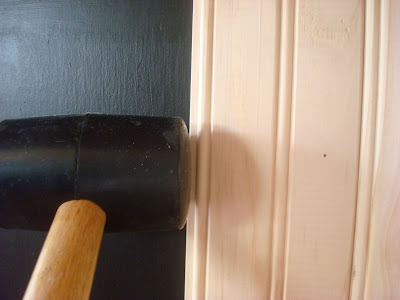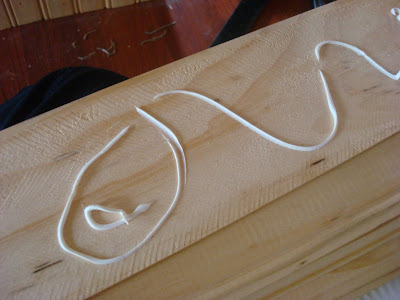My little family ended the day with a Kentucky Fried Chicken dinner -- it's what I wanted and Momma gets what she wants. (At least today I do.) I hope all of you who are Mommy's had a wonderful day, and I hope all of you that are waiting to be a Momma had a wonderful day as well. :)
Anyhoo, you have probably guessed by now that the island redo involves beadboard. I just had to cover the laminate -- since I didn't use the primer and the paint was coming off in most spots, I was really over it. So I just decided to cover the whole freakin' thing. And I LOVE IT.
So I wanted to show you how to install this luscious stuff. First of all -- if there is any trim on the island, or on the wall you are working with, you'll need one of these thingamagigs. The name of them has completely escaped me. Soooooo tired people:
 You'll want to use a rubber mallet with it, and this will probably be the most fun you'll have on the whole project. Don't be afraid ladies! Smack that baby! Tear it up!!
You'll want to use a rubber mallet with it, and this will probably be the most fun you'll have on the whole project. Don't be afraid ladies! Smack that baby! Tear it up!!If you are installing beadboard on a wall, I recommend you remove the baseboards first. You don't have to by any means. It will just look more custom when you reinstall the baseboards over the beadboard. On the island, I removed the corner molding and the quarter round.
If there are any nails from the molding stuck in the wall/island, just use a wrench to pry them out:
 Next up, measure the height you need and cut away. In my laundry room, I did it fairly high, around five feet. In our son's bathroom, I did it at about 33 inches. The latter is pretty standard. Basically, any height goes!:
Next up, measure the height you need and cut away. In my laundry room, I did it fairly high, around five feet. In our son's bathroom, I did it at about 33 inches. The latter is pretty standard. Basically, any height goes!:You'll need a good glue, like liquid nails. Put a bead of it along the back of the board:
Use a level and check it. The first piece is most important. And beadboard is sooooo forgiving...if subsequent pieces aren't perfect, you can make them level even if there is some space between them. After it's painted you won't even notice little imperfections:
 I find this next step very important -- before you nail each piece, check the next one to make sure they will slip together OK. Then, you'll want to pull the edge of the piece you just glued on up a bit on the side that slides together. Then slide your next piece on, and nail in the previous piece. Does that make sense? If you nail one beadboard piece down, it can be really hard to get the next one in, just because it's so close to the wall:
I find this next step very important -- before you nail each piece, check the next one to make sure they will slip together OK. Then, you'll want to pull the edge of the piece you just glued on up a bit on the side that slides together. Then slide your next piece on, and nail in the previous piece. Does that make sense? If you nail one beadboard piece down, it can be really hard to get the next one in, just because it's so close to the wall:I should mention here that you can also purchase large sheets of "faux" beadboard and have it cut or cut it the size you need. It's just a large panel, so the installation is much easier -- glue the panel up and nail in a few spots to secure it. I just love the look of real beadboard and I think it's fun to install. The pieces lock together kind of like flooring.
Take your mallet and tap each piece into the next one, checking level as you go (or at least every few pieces):
 If you have to work around an outlet, you'll have to use your hand saw to cut shape out that you need. To get the vertical cut, (like to the right of the outlet here), I used a blade and scored it well, then just popped it off with a wrench. Especially if you are painting it black, you will never see any little imperfections:
If you have to work around an outlet, you'll have to use your hand saw to cut shape out that you need. To get the vertical cut, (like to the right of the outlet here), I used a blade and scored it well, then just popped it off with a wrench. Especially if you are painting it black, you will never see any little imperfections:That's basically it. Bead board is EXTREMELY easy to install. The hard part is getting the pieces cut. Here's a few tips:
1. If you have an electric saw, this helps immensely. I did most of the island with my miter box and hand saw before my hand was about to fall. off. With the miter saw it was like I had died and gone to heaven. (I cannot believe I haven't bought one till now.) If you have a compound miter saw, make all your cuts beforehand, and installation will be a breeze.
2. If you don't have a saw, the home improvement store may cut them for you. Their blades are pretty heavy duty and beadboard is not. So they may or may not do it - ask them first. If you don't want to cut them by hand with a miter box, you'll have to find someone who has a saw to help you out.
3. You'll have some spots that will need skinny pieces of molding -- like when you get to the end of a wall. Again, the home improvement store may not cut this for you. Helps to have a friend for this part as well. Good thing is, you will need very few of these cuts done. And again, they don't have to be perfect. Caulk is your BFF.
I will show you the final pics of the island tomorrow. Stop yelling at me! I know!! I took some tonight and they look like crappola, so you'll have to be a little more patient so I can take them in the light.
Tomorrow I'll share how to deal with corners and how to paint beadboard. Have a wonderful Monday!
P.S. I said "piece" about 76 times in this post.










